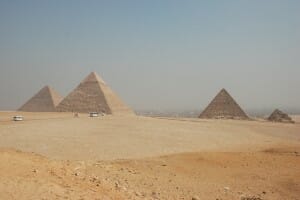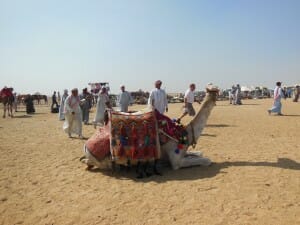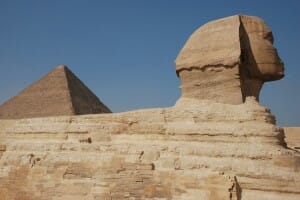
For decades, I maintained a mental list of cities and countries. This list included places that I had no desire to visit. In casual conversations, I would say—”I’m NEVER going to visit…!” Egypt and specifically Cairo were near the top of that list. I didn’t want to spend a penny in a country that struggled to live in peace with its neighbor, Israel. By using the word NEVER, I intentionally limited my future travel destination list.
Was it right to exclude a travel destination for political reasons?
In 1979, I watched on television the historic signing of the peace agreement by Egyptian President Anwar El Sadat and Israeli Prime Minister Menachem Begin and witnessed by United States President Jimmy Carter. Even with this famous peace agreement, my opinion didn’t change. I could spend my entire life traveling and still not cover every inch of the planet.
It was only logical to pick the places near the top of the list rather than the ones close to the bottom. But like other things in life, some of my stronger beliefs mellowed with time. I gradually adopted a viewpoint that gravitated toward being more flexible.
This evolving mindset broadened while living as an expat teacher in India. After writing May This Be the Best Year of Your Life, I realized the importance of accepting situations outside my comfort zone. I became more open to expanding my future travel destination list. Simultaneously, I accept the fact that dangerous places need to be avoided. Travel safety is always a top priority.
It’s rare that one cruise itinerary includes all of my “must see” places in a region and is set at a reasonable price point. During the final selection process, it’s oftentimes necessary to make compromises. Some potential ports are on my “bucket list” while others are much further down the list.
A few years back when we considered a Mediterranean cruise that included Middle East ports of call, Israel was a high priority while Egypt was still lingering as a less than desirable option. But, at the same time, the fascination with Ancient Egypt offset my trepidations. How awesome would it be to travel to Giza to see pyramids and a sphinx?
Hmm…I pondered the idea of removing Egypt from my NEVER list. After all, hadn’t I done a similar thing when I added Jordan’s Petra to an Israel land trip just a few years earlier?

I NEVER thought that I’d step foot in Jordan. But during Israel’s 60th anniversary year, I jumped at the chance to visit Petra. Once again, I had to eat my words. I have to admit that it’s foolish to recite the word— “NEVER.” Absolute statements are usually impossible to stand by.
My husband and I made reservations for a 14-day Mediterranean fall Celebrity cruise that included visits to Cairo (Alexandria- 2 days),Egypt, Ashdod (2 days) and Haifa, Israel (1 day) as well as European cities.
Like other savvy cruise passengers, we know that some ports are easier to manage than others. Egypt is a place where prearranged shore excursions are a wise choice. Bouts of political unrest, potential language barriers, and the fact that my husband and I were Jews traveling in an Arab country made us favor being in a group tour and remaining inconspicuous. Based on the recommendations from Carolina Ortiz, the Celebrity Cruise Excursion Director, we opted for the all-day Classic Cairo excursion.
After leaving the port area, the bus drove through the streets of Alexandria and then headed to the highway. While in the urban area, our window view revealed an overabundance of litter and numerous dilapidated buildings. Similar to other developing countries, it appeared that the environment wasn’t a top priority. Excessive amounts of roadside trash made me think of India.

Over time, the landscape became an endless desert. After a 3+ hour drive, our first stop was at the Western Plateau. At the Giza Plateau, we could view the Pyramids of Giza. We had the vantage point of seeing all of the pyramids with the city of Cairo in the background. Some of our fellow travelers opted for overpriced, short camel rides. A previous Bedouin camel experience in Israel’s Negev Desert had satisfied our desire to ride a camel.
As we exited our air conditioned bus, souvenir vendors swarmed around the bus passengers as the bright sun and the heat of the desert embraced us. Without any warning, we were grabbed by several children. They were eager to practice their aggressive salesmen skills on the unsuspecting passengers. It was a challenge to release ourselves from their grimy grip. A few armed Egyptian guards wandered aimlessly.
Standing in front of the towering pyramids, I remembered a visit to

London’s British Museum. Treasures that were intended for a glorious afterlife were now thousands of miles away on display in a museum while the inside of the pyramids were barren. I doubt that the leaders of Ancient Egypt ever anticipated such a twist of fate.
Then again, our tour guide told us that an untold number of artifacts were stolen by robbers who invaded the tombs long before the British arrived.
Since my childhood, I was fascinated with this ancient culture that put an intense emphasis on life after death. The whole mummification process is filled with intrigue and mystery. Even though the concept runs counter to my Judaic beliefs, my curiosity remains whenever I see mummies.
Near the base of the second pyramid, I felt something sharp inside my shoe. A narrow piece of metal had pierced through the sole of my walking shoe. Fortunately, I sensed the object before it penetrated my skin. Ira was able to remove the nuisance while a new group of peddlers continued to harass us.
Looking up at the pyramids, I was in awe. How did this ancient group of people figure out how to place huge slabs of stone on top of one another to form the pyramid? Like others who had visited this historical place, I was perplexed by the mysteries that continue to flouish. Scientists and historicans are still attempting to learn how the Ancient Egyptians built the pyramids without the use of modern machinery. Each block of limestone weights approximately two tons.
Some of our fellow travelers paid a fee to enter the empty tombs. Instead, we chose to walk around the pyramids and explore an adjacent site. We took a short bus ride to reach the nearby Sphinx.

Adjacent to the Sphinx was the Khafre’s Valley Temple. The reign of Khafre was from 2520 to 2494 B.C.E. This structure was made of limesone, Aswan red granite and had an alabaster floor. Off in the horizon, we could faintly see Cairo’s skyline, a reminder of modern times.
Our guide provided a couple of explanations for why the nose on the Sphinx was deformed. The following day, our Alexandrian guide provided another reason. Like other historical mysteries, one may never know for certain what caused a particular event.
Returning to Cairo, we encountered a major traffic jam. We eventually visited the Papyrus Institute, a tourist trap. An Egyptian woman demonstrated how the ancient Egyptian paper was made from reeds from the Nile River. Techniques include a thorough soaking of the paper and the use of a special press. Issues between fellow travelers and the store personnel caused the bus to leave late.
After participating in many full-bus cruise excursions, I’m aware of this pitfall. Inconsiderate cruise passengers don’t always return at the designated departure time or wait to the last second to make onsite purchases. Unless, you choose to take a private tour, you’re subject to the whims of the other passengers.
On the way to the National Archaeological Museum, we passed by Tahrir Square. Months before our visit, protesters gathered and voiced their opposition to the Egyptian government. Nearby buildings such as the National Party Headquarters and a hotel were ablaze. Just a few yards away, the National Archaeological Museum was spared, but there were unsubstantiated reports of looting. Surprisingly, the remarkable collection of antiquities didn’t catch fire. Since the writing of the original blog, agitated protesters have continued to gather in this area.
(Please note that the official government link for the museum website does not always work. For basic information check an nonofficial site like Wikipedia.)
Since this group tour didn’t remain on schedule, the guide had to cut the last stop short. She provided an abbreviated overview of the King Tutankhamen exhibit and then we had about 30 more minutes to scurry through the ancient treasures. Poor lighting and missing or difficult signage limited our understanding of the exhibits.
This museum scenario stands in sharp contrast to the British Museum that has excellent signage, proper lighting, and full explanations. In London, I was able to take hundreds of pictures. In Egypt, cameras were not allowed inside the museum. My memories are back up by a 63-page guidebook, Masterpieces of the Egyptian Museum. Unfortunately, the images only showcase a tiny fraction of the museum holdings.
Years later, I’m glad that I didn’t let my stubbornness prevent me from seeing one of the Wonders of the Ancient World. Had I adhered to my original conviction to never visit Egypt, I would have missed out on this amazing part of history.
CAN YOU SHARE?
Have you ever compiled a NEVER list? If so, has your list changed over time?
RELATED POSTS
An Afternoon in Alexandria, Egypt
Exploring Ancient Civilizations at the British Museum, London
A Step Back in Time- The Jewish Catacombs in Rome
A Step Back in Time: The Jewish Catacombs in Rome
This story is an updated version of a blog posted several years ago.
BIO
Sandra Bornstein is a freelance travel and lifestyle writer. She shares her experiences and recommendations on this blog and on other websites. Check out Sandra’s second website, https://thetravelingbornsteins.com. It exclusively focuses on travel.
Sandra contributes a monthly travel tip column for Golden Living, a Best Version Media magazine. She also writes for Fareportal’s online sites—One Travel Going Places and CheapOAir Miles Away.
Sandra is the author of MAY THIS BE THE BEST YEAR OF YOUR LIFE. This memoir highlights Sandra’s living and teaching adventure in Bangalore, India. As a licensed Colorado teacher, Sandra has taught K-12 students in the United States and abroad. She also taught college level courses.
Sandra’s memoir was a finalist in the Travel category for the 2013 Next Generation Indie Book Awards, the 2013 International Book Awards, the 2013 National Indie Book Excellence Awards, 2013 USA Best Book Awards, and a Honorable Mention award in the Multicultural Non-Fiction category for the 2013 Global ebook Awards.
Leave a Reply
You must be logged in to post a comment.